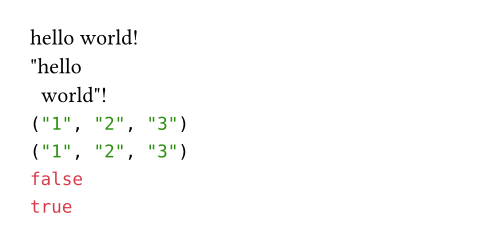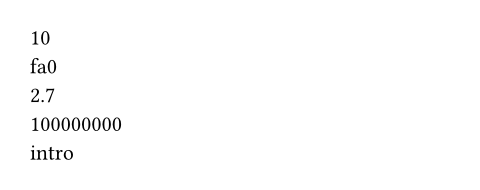str
A sequence of Unicode codepoints.
You can iterate over the grapheme clusters of the string using a for
loop. Grapheme clusters are basically characters but
keep together things that belong together, e.g. multiple codepoints that
together form a flag emoji. Strings can be added with the + operator,
joined together and multiplied with integers.
Typst provides utility methods for string manipulation. Many of these
methods (e.g., split, trim and replace) operate on patterns: A
pattern can be either a string or a regular expression. This makes
the methods quite versatile.
All lengths and indices are expressed in terms of UTF-8 bytes. Indices are zero-based and negative indices wrap around to the end of the string.
You can convert a value to a string with this type's constructor.
Example
#"hello world!" \
#"\"hello\n world\"!" \
#"1 2 3".split() \
#"1,2;3".split(regex("[,;]")) \
#(regex("\d+") in "ten euros") \
#(regex("\d+") in "10 euros")

Escape sequences
Just like in markup, you can escape a few symbols in strings:
\\for a backslash\"for a quote\nfor a newline\rfor a carriage return\tfor a tab\u{1f600}for a hexadecimal Unicode escape sequence
构造函数参数参数是传给函数的输入,写在函数名后的括号中。
Converts a value to a string.
- Integers are formatted in base 10. This can be overridden with the
optional
baseparameter. - Floats are formatted in base 10 and never in exponential notation.
- From labels the name is extracted.
- Bytes are decoded as UTF-8.
If you wish to convert from and to Unicode code points, see the
to-unicode and from-unicode
functions.
#str(10) \
#str(4000, base: 16) \
#str(2.7) \
#str(1e8) \
#str(<intro>)

定义定义这些函数和类型带有附属定义。要访问这种定义,请先写上函数或类型的名称,再加上定义的名称,并用句点在中间分隔。
first
Extracts the first grapheme cluster of the string. Fails with an error if the string is empty.
last
Extracts the last grapheme cluster of the string. Fails with an error if the string is empty.
at
Extracts the first grapheme cluster after the specified index. Returns the default value if the index is out of bounds or fails with an error if no default value was specified.
index
The byte index. If negative, indexes from the back.
defaultany
A default value to return if the index is out of bounds.
slice
Extracts a substring of the string. Fails with an error if the start or end index is out of bounds.
start
The start byte index (inclusive). If negative, indexes from the back.
end
The end byte index (exclusive). If omitted, the whole slice until the end of the string is extracted. If negative, indexes from the back.
默认值: none
count
The number of bytes to extract. This is equivalent to passing
start + count as the end position. Mutually exclusive with end.
clusters
Returns the grapheme clusters of the string as an array of substrings.
codepoints
Returns the Unicode codepoints of the string as an array of substrings.
to-unicode
Converts a character into its corresponding code point.
展开例子
#"a".to-unicode() \
#("a\u{0300}"
.codepoints()
.map(str.to-unicode))

character
The character that should be converted.
from-unicode
Converts a unicode code point into its corresponding string.
展开例子
#str.from-unicode(97)

value
The code point that should be converted.
contains
Whether the string contains the specified pattern.
This method also has dedicated syntax: You can write "bc" in "abcd"
instead of "abcd".contains("bc").
starts-with
Whether the string starts with the specified pattern.
ends-with
Whether the string ends with the specified pattern.
find
Searches for the specified pattern in the string and returns the first
match as a string or none if there is no match.
position
Searches for the specified pattern in the string and returns the index
of the first match as an integer or none if there is no match.
match
Searches for the specified pattern in the string and returns a
dictionary with details about the first match or none if there is no
match.
The returned dictionary has the following keys:
start: The start offset of the matchend: The end offset of the matchtext: The text that matched.captures: An array containing a string for each matched capturing group. The first item of the array contains the first matched capturing, not the whole match! This is empty unless thepatternwas a regex with capturing groups.
matches
Searches for the specified pattern in the string and returns an array of dictionaries with details about all matches. For details about the returned dictionaries, see above.
replace
Replace at most count occurrences of the given pattern with a
replacement string or function (beginning from the start). If no count
is given, all occurrences are replaced.
replacement
The string to replace the matches with or a function that gets a dictionary for each match and can return individual replacement strings.
count
If given, only the first count matches of the pattern are placed.
trim
Removes matches of a pattern from one or both sides of the string, once or repeatedly and returns the resulting string.
split
Splits a string at matches of a specified pattern and returns an array of the resulting parts.